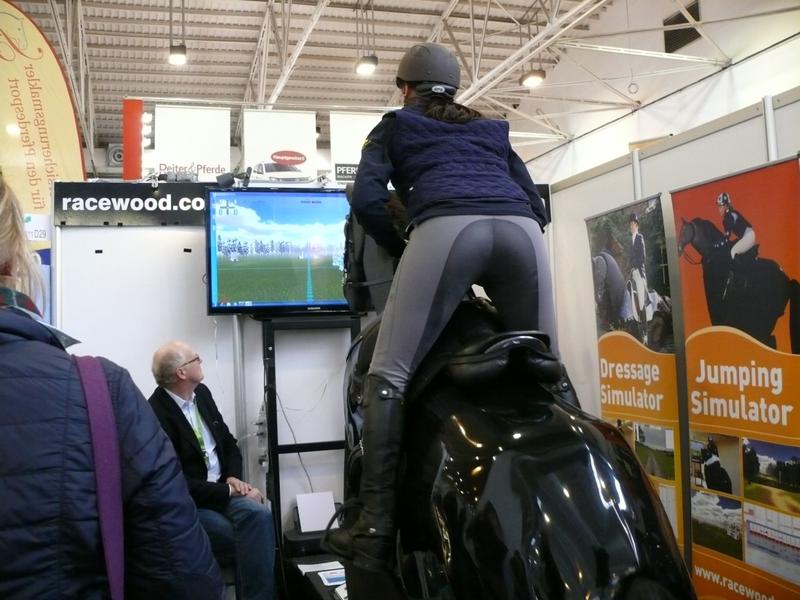
The Complexity of Horse Riding vs. Simulators Explained

A riding simulator allows specific training of certain movements.
Photo: Manuela Wulf
Flight simulators for the training of air pilots are well known. But what about riding simulators? Although the first horse simulator was used at the French National Equestrian School in Saumur already in the 1980s, riding simulators for dressage, show jumping, polo or racing, have become available only recently.
They look like horses and respond to the aids of the rider via sensors which measure the force exerted by the reins and the rider’s legs. Via a screen in front of the simulator, the rider immerses himself into a virtual equestrian world.
Simulators are aimed at competitive sports
Riders and jockeys use simulators to repeat movement sequences, improve their position in the saddle or simulate the finish of a race, but they also train to avoid injuries when falling off a horse. Jockeys also use riding simulators to regain their physical fitness after injuries. „A riding simulator always responds in the same way and thus allows standardised training programmes” says Natascha Ille from the Vetmeduni Vienna, first author of the study.
Riding a horse is more demanding
Ille and her co-workers from the Graf Lehndorff Institute for Equine Science, a joint research unit of the Brandenburg State Stud and the Vetmeduni Vienna, tested the response of 12 riders in a show jumping course. They compared the riders’ stress hormones, heart rate and heart rate variability when riding a horse and a riding simulator.
The riders’ heart rate was higher when riding a horse than during simulator-based training. „A horse is the bigger challenge compared to a simulator. The movement characteristics of a horse are more complex and the response of a horse in a given situation is only partially predictable. Riding a simulator is thus physically and psychologically less demanding for riders“, explained Ille.
Heart rate data indicate that the training on a horse had a more pronounced stimulatory effect on the riders` sympathetic nervous systems compared to the training on the simulator. Sympathetic activity is known to increase the body´s performance potential in sportive activities.
Analysis of the stress hormone cortisol in saliva collected from the riders also suggests a stress reaction on the simulator. „This may be due to a novel experience for the riders. Participants in the study had never trained on a simulator before, but were well accustomed to working with horses“, Ille suggests.
„Our results demonstrate that riding a horse is far more complex for the human body than riding a simulator“, summarises project supervisor Jörg Aurich. „However, riding simulators could be an excellent preparation for beginners before they mount a horse for the first time. For competitive riders and jockeys, simulators could be a valuable addition to the training with horses”.
Service:
The article “Riding simulator training induces a lower sympathetic response in riders than training with horses”, by Natascha Ille, Mareike von Lewinski, Christine Aurich, Regina Erber, Manuela Wulf, Rupert Palme, Bill Greenwood and Jörg Aurich was published in the Journal of Equine Veterinary Science. doi:10.1016/j.jevs.2015.06.018
http://www.sciencedirect.com/science/article/pii/S0737080615004256
Video:
https://www.youtube.com/watch?v=b0zqWJUaZnk&feature=youtu.be
About the University of Veterinary Medicine, Vienna
The University of Veterinary Medicine, Vienna in Austria is one of the leading academic and research institutions in the field of Veterinary Sciences in Europe. About 1,300 employees and 2,300 students work on the campus in the north of Vienna which also houses five university clinics and various research sites. Outside of Vienna the university operates Teaching and Research Farms. http://www.vetmeduni.ac.at
Scientific Contact:
Mag. Natascha Ille
Insemination and Embryotransfer Platform
University of Veterinary Medicine Vienna (Vetmeduni Vienna)
T +43 1 25077-5402 or +43 1 25077-6422
natascha.ille@vetmeduni.ac.at
Released by:
Susanna Kautschitsch
Science Communication / Public Relations
University of Veterinary Medicine Vienna (Vetmeduni Vienna)
T +43 1 25077-1153
susanna.kautschitsch@vetmeduni.ac.at
http://www.vetmeduni.ac.at/en/infoservice/presseinformation/press-releases-2015/…












